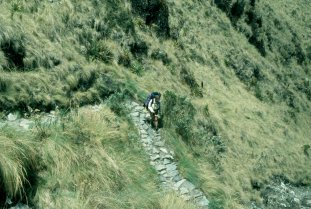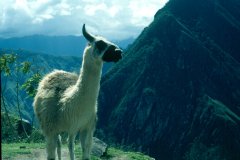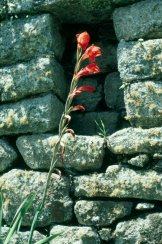|
|
Inca Trail - Phuyuptamarca by Joe Mazzarella - added January 31, 2007

 Finally, at about 6:30 am the weather receded from heavy rain to
damp mist again and we were able to scarf down some breakfast, break camp, and hit
the path. The shutter of my camera was still jammed, unfortunately. What weight we
had lost on our backs from two days worth of meals, we easily gained back in a rain
soaked tent, packs, and gear. The beauty of the hike ahead, however, was a day I
will never forget. As we skirted the cloud forest towards the third pass, the road
that was leading us became even more impressive. We walked along the trail staring
at the tops of trees because of the steepness of the slope that the trail is cut into. Finally, at about 6:30 am the weather receded from heavy rain to
damp mist again and we were able to scarf down some breakfast, break camp, and hit
the path. The shutter of my camera was still jammed, unfortunately. What weight we
had lost on our backs from two days worth of meals, we easily gained back in a rain
soaked tent, packs, and gear. The beauty of the hike ahead, however, was a day I
will never forget. As we skirted the cloud forest towards the third pass, the road
that was leading us became even more impressive. We walked along the trail staring
at the tops of trees because of the steepness of the slope that the trail is cut into.

 The drop-off on the left sometimes reached fifty feet or more.
At one point the trail approaches a rock cliff that would deter many ancient
road-builders, but the Incas "simply" cut a tunnel down and through the cliff that
emerges into the light again 20 meters later. After crossing the third pass, the
trail descended steeply into the high jungle. We followed the stairs down to the
ruins of Phuyuptamarca, aptly meaning "cloud level town". Although the rainy season
weather we experienced didn't allow us to see them, on clear days huge snowcapped
Andean peaks can be seen from this lookout and many others on the trail. As we
continued down, we could feel the warm, damp, jungle air meet us with each Inca
stair. The descent, although steep and hell on the knees, was a wonder for the
senses as we passed through thick vegetation of vines, reeds, and moss covered
trees ... another unique micro-climate of the Inca Trail. The other hikers on
the trail were dispersed now, and as Julie and I walked alone through the jungle
listening to the various strange bugs and birds, my imagination was giving me a
sense of discovery as if I was the first white person ever to walk on these stones.
I wondered how Hiram Bingham, the Yale explorer whom reportedly "discovered" the
Inca Trail in 1915, had felt. It must have taken him and his team weeks to machete
their way through this dense section of trail. I also wondered if one was to smash
their broken camera on an Inca stone in the jungle and no one was around to hear
it, would it make a sound? Actually, by now we were immersed in the natural wonders
around us and despite its weight, the camera was an afterthought. The drop-off on the left sometimes reached fifty feet or more.
At one point the trail approaches a rock cliff that would deter many ancient
road-builders, but the Incas "simply" cut a tunnel down and through the cliff that
emerges into the light again 20 meters later. After crossing the third pass, the
trail descended steeply into the high jungle. We followed the stairs down to the
ruins of Phuyuptamarca, aptly meaning "cloud level town". Although the rainy season
weather we experienced didn't allow us to see them, on clear days huge snowcapped
Andean peaks can be seen from this lookout and many others on the trail. As we
continued down, we could feel the warm, damp, jungle air meet us with each Inca
stair. The descent, although steep and hell on the knees, was a wonder for the
senses as we passed through thick vegetation of vines, reeds, and moss covered
trees ... another unique micro-climate of the Inca Trail. The other hikers on
the trail were dispersed now, and as Julie and I walked alone through the jungle
listening to the various strange bugs and birds, my imagination was giving me a
sense of discovery as if I was the first white person ever to walk on these stones.
I wondered how Hiram Bingham, the Yale explorer whom reportedly "discovered" the
Inca Trail in 1915, had felt. It must have taken him and his team weeks to machete
their way through this dense section of trail. I also wondered if one was to smash
their broken camera on an Inca stone in the jungle and no one was around to hear
it, would it make a sound? Actually, by now we were immersed in the natural wonders
around us and despite its weight, the camera was an afterthought.

 By early afternoon we had arrived at the ugly and disgraceful
visitor center and campground, which we quickly blew off due to the crowds and
craziness. Most people and guided groups camp here, drink beer (yes, there even
is a bar!), and arise at 4am to try to catch the sunrise over Machu Picchu, about
two hours away. After visiting the beautifully terraced and peaceful ruins of Winay
Wayna, only five minutes from the visitor center, we continued our way towards
Machu Picchu. The last leg of the trail has a gate that closed at 2:30 pm, just
as we passed through it. After sharing some coca leaves with the guard, we embarked
on one of the most special sections of the trail for us. Due to our timing or
lateness, we once again had this leg of the trail to ourselves as the rain set
in intermittingly through the canopy of the high rainforest. As we meandered along,
we passed huge, moss covered trees with plants dangling from their limbs ... leaves
the size of my chest ... hummingbirds of assorted colors ... and the ever-present
rock walkway, sturdy as ever. This incredible two-hour walk ended with a steep
stairway ascending to the ridge, revealing a breathtaking view of the legendary
lost city of Machu Picchu, with the sun shining through the clouds onto the mountain
spine where the ruins lay. Towering above and behind the sacred city is the mountain
of Huayna Picchu. Due to the time of day and the rainy afternoon, the ruins were
devoid of people. I had never seen a view as naturally and supernaturally beautiful
as this. I couldn't wait to explore the place, but I had to because it was almost
dark. We needed to get to the river on the valley floor to set up camp. We slept
that night along the banks of the Urabamba River in our wet sleeping bags and tent,
fighting the jungle heat, bugs, and humidity. It didn't matter. By early afternoon we had arrived at the ugly and disgraceful
visitor center and campground, which we quickly blew off due to the crowds and
craziness. Most people and guided groups camp here, drink beer (yes, there even
is a bar!), and arise at 4am to try to catch the sunrise over Machu Picchu, about
two hours away. After visiting the beautifully terraced and peaceful ruins of Winay
Wayna, only five minutes from the visitor center, we continued our way towards
Machu Picchu. The last leg of the trail has a gate that closed at 2:30 pm, just
as we passed through it. After sharing some coca leaves with the guard, we embarked
on one of the most special sections of the trail for us. Due to our timing or
lateness, we once again had this leg of the trail to ourselves as the rain set
in intermittingly through the canopy of the high rainforest. As we meandered along,
we passed huge, moss covered trees with plants dangling from their limbs ... leaves
the size of my chest ... hummingbirds of assorted colors ... and the ever-present
rock walkway, sturdy as ever. This incredible two-hour walk ended with a steep
stairway ascending to the ridge, revealing a breathtaking view of the legendary
lost city of Machu Picchu, with the sun shining through the clouds onto the mountain
spine where the ruins lay. Towering above and behind the sacred city is the mountain
of Huayna Picchu. Due to the time of day and the rainy afternoon, the ruins were
devoid of people. I had never seen a view as naturally and supernaturally beautiful
as this. I couldn't wait to explore the place, but I had to because it was almost
dark. We needed to get to the river on the valley floor to set up camp. We slept
that night along the banks of the Urabamba River in our wet sleeping bags and tent,
fighting the jungle heat, bugs, and humidity. It didn't matter.
[Dead Women's Pass, Day 2] [Travel Journal Index] [Machu Picchu, Day 4]
|
|

